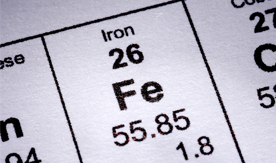
UMaine Researchers Studying Availability of Iron in Ocean, Primary Production
Understanding why phytoplankton — the base of the food web — are not able to use all the iron in seawater is the focus of a three-year study by University of Maine researchers.
Mark Wells, a marine science professor at UMaine, is leading the project that will look at how the chemistry of iron in seawater is controlled by tiny particles, where the particles are most important, and how the chemistry of the particles affects the ability of phytoplankton to grow on iron in seawater.
Oceans contribute about 50 percent of the world’s photosynthesis, with the majority coming from marine phytoplankton, Wells says. The growth of the single-celled organisms in many ocean regions is limited by the availability of micronutrient iron.
The researchers will meld chemistry, physics and biology to learn more about dissolved iron in the ocean that is tied up in colloidal particles, which are too small for gravity to control, and therefore don’t sink in seawater.
“The question is whether the marine colloids are releasing iron, or gathering it up, and this pattern almost certainly will change for different waters,” Wells says. “It is like a Tic Tac container. The Tic Tacs are there but you have to wait for the container to release them before you can eat them.”
Bioavailable iron is an essential nutrient for shaping the distribution and composition of marine phytoplankton production, as well as the magnitude of ocean carbon export, the researchers say. Iron exists in many phases in the ocean and colloidal, or nonsoluble, phases account for a significant portion of dissolved iron.
The colloidal phase of iron may serve as a biological source of stored iron, according to the researchers, but the physical and chemical characteristics of these phases are presently poorly understood.
“We know the particles are there, but we haven’t had the techniques to really see them in a technical way, and that’s what makes this project unique,” Wells says.
To better understand this key part of iron cycling, researchers will use new analytical chemistry methods to quantitatively separate the colloidal iron sizes present in a sample and measure the composition of the colloidal portions in shelf and oceanic waters.They will use flow field-flow fractionation (flow FFF) with multi-angle laser light scattering to make measurements of the uniformity or uniqueness of the colloidal size spectrum, as well as the physical and chemical characteristics of the phases. Flow FFF, according to Wells, uses flow in thin streams along a membrane to separate small particles by size.
“Researchers in the past have just used filters, but filters aren’t a very efficient way to separate size,” Wells says.
Using this method will allow the researchers to learn more about the shape, size range and chemical composition of the particles.
“A mixture of particle sizes go in one end of the channel but particles come out the other in order of their size. We can use the method to determine what particle sizes have the most iron in them,” Wells says.
The findings will aid future studies to better link the source and fate of iron in the marine environment, according to the researchers, who also expect the project will have broad implications in the fields of marine ecology and biogeochemistry and to modeling studies of ocean-atmospheric coupling and climate change.
“This study will help us understand where iron will be more available and less available in the oceans, which will help us understand why ocean productivity is lower in some areas than others,” Wells says.
The project, “Assessment of the colloidal iron size spectrum in coastal and oceanic waters” recently received a $269,334 grant from the National Science Foundation.
A former UMaine postdoctoral researcher, who is now a Texas A&M University professor, will serve as a principal investigator on the project that also will support the education and research training of one undergraduate student each year. The researchers plan to conduct outreach activities to K–12 students and teachers.
Contact: Elyse Kahl, 207.581.3747
